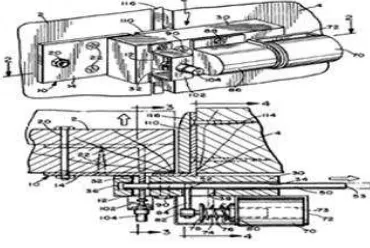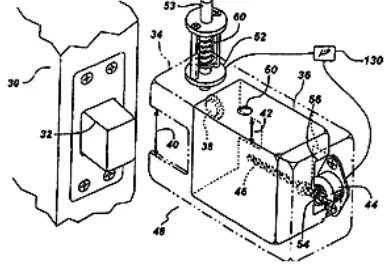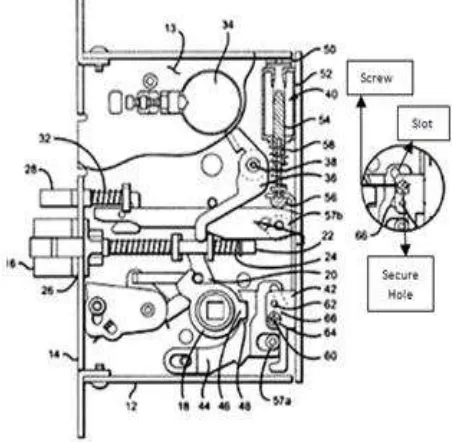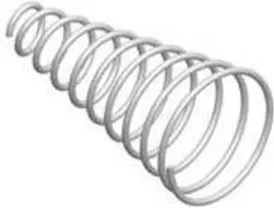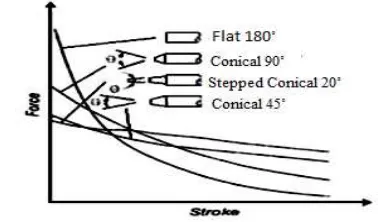Volume 2, Issue 5, November 2012
Abstract- This article presents a critical review of electromechanical door locking system. Electromagnetic lock is currently widely used in the market. But it has common disadvantages such as low break-in force, and requires continuous power supply in order to maintain the locked state, higher power consumption and limited life of the back-up battery. Power supply failure may drain the back-up battery due to the necessity of providing continuous supply of electrical energy to maintain the locked state of the door. Hence the electromechanical takes the role as a competitor. To challenge the magnetic type lock, solenoid now become preferable instrument for automatic door locking as they can save energy up to 50 percent or more. Market demand shows that the fail secure and fail safe modes are now priorities. Fail safe mode of a lock describes a mode wherein the door can be opened by the lock doorknob when power to the lock is turned off or malfunction. Conversely, the fail secure mode describes a mode wherein the door cannot be opened by the doorknob when power to the lock is off or malfunction. Ten types of electromechanical door lock with recent development were analyzed and revealed here. On top of that, a new innovative solution is proposed to be the best of all above in term of power saving, performance, quality and efficiency.
Keywords- Electromechanical Door Lock, Solenoid Lock, Fail Safe And Fail Secure.
I. INTRODUCTION
Buildings and items such as lockers, safes and security vaults containing valuables are commonly secured with locks against possible theft or unauthorized access. Locking systems may work by mechanical or electronic means, or both. Electro-mechanical locks are beneficial as they can be coupled to various mechanical types of security access systems which provides an easy and flexible human traffic flow into premises with the help of electronic physical object (Such are keycard, fingerprint, RFID card and security token) or secret information (such as a keycode or password), or combination of both. They can also be connected to other security features such as unauthorized entry alarms. Market demand shows that, the aspect of lock design could be improved concurrently towards secure, energy saving and function efficiency.
The application of mode fail safe and fail secure in door locking system must be considered in safety aspect. Failsafe locks are the often used for life safety applications such as the access control of perimeter fire exit doors and high rise building stairwell doors where the locks can be released during an emergency or building failure. When used on interior doors that do not require connection to the life safety command center, battery back-up power supplies may be used to provide continuous power to electric locks and strikes during a power failure or system malfunction. Failsafe strikes are not permitted for use on fire doors because these doors must stay latched even when unlocked to maintain fire door integrity. A failsafe strike is incapable of keeping a fire door latched when unlocked, thereby permitting smoke, gases or flame to travel through the opening during an emergency.
Fail secure locks require power to unlock. When energized by use of an access control the door unlocks. The door doors because they do not unlock during an emergency power failure. Fail secure electric strikes may be used on most fire doors equipped with mechanical locksets that are not locked on the interior, ensuring free egress at all times. However, fail secure door lock may not be used for fire stairwell doors or any fire door that is considered a 2-way exit during emergencies.
II. REVIEWOFPREVIOUSWORK
From the U.S. patent as in [1], design shown in fig.1 present the invention is correlated to fail-safe electric actuators and more particularly concerned with an improved actuator. Solenoid is a main electrical part that involved in actuating the plunger for locking purposes. In the event of solenoid de-energize, the solenoid is actuated by a spring to an inactive position, and incorporates as a fail-safe feature when magnetic force generated for supplementing the spring action and assure movement of the mechanism to the inactive position even though the spring failure. This lock design shows the integrated between solenoid function and springs
Critical Review of Electro-Mechanical Door
Locking System and Proposal towards
Development of Innovative Super Energy Saving
Door Locking System
Sivarao, Abdul Alif, Taufik, Yuhazri, Haery Ian, Robert K. M., Tin S. L.
Faculty of Manufacturing Engineering
Volume 2, Issue 5, November 2012 reaction. The spring operate with the bolt and being
compressed when the bolt is actuated (solenoid energize) to unlocking position and utilized bolt to unlock position. Design also consists of two magnets are mounted in their respective position like pole face to face where purposely to ensure the bolt react independently to move the bolt unlocked position in the event of spring fail. In term of the mechanical design perspective defined the door was not automatically function. The door required the users to instruct the door to open and lock, hence this shows that the door is not offering energy saving or fulfill any convenience to the user, despite providing the fail-safe feature with supplementing the spring action.
Fig. 1: Failsafe Means for Solenoid Actuated Devices (U.S. Patent No. 751,086)
The similar drawback coupled with lack of electricity savings shows by U.S. patent as in [2]. This door shown in fig. 2 consists of a bolt plate mounted on a door with an aperture for receiving a sliding bolt. Solenoid is an electrical device that is used to actuate the bolt to lock the door and to engage a hole in the latch. This type of lock comprises a latch plate that can be mounted on the door which has a latch tongue with an opening for receiving a locking bolt. A bolt mounted within a bore in the block purposely to engaging the opening in the tongue of the latch. Latch is loaded by a compression spring in the engaged position. The solenoid plunger also loaded by a compression spring and connected to the power source for the motor of an overhead electric door opener. In that particular design, when the motor is energized to open the door, the solenoid will also be energized to disengage the latch tongue from the bolt, hence the power will utilize to operate the motor and hold the solenoid stroke upon the door open.
Fig. 2: Electromechanical Door Lock System, (U.S. Patent No. 4,917,419)
Reference [3] also revealed the solenoid as an actuator to actuate the mechanical instrument. This lock design is focused to an electrically operated door system, the locking mechanisms are holding a latch keeper in locking position to prevent opening of the door. Meantime, the solenoid holds a latch keeper in a locking position. The spring is used to biasing the solenoid plunger to a rest position and is being compressed when solenoid is electrically energized in order to move the plunger. Hence, it shows that keepers being generally biased by a spring in position to engage a door latch. This condition of system revealed that strike is in unlocked position when solenoid energized and does not require electricity when strike is in locked position. The lock is installed or being suspended in a door frame by a multiple of hinges and also having a latching within the frame of the door in the closed position. The door has a latch which protrudes from the center of the edge of the door. As a supplementary and provide convenience to the users, the latch is operated by a key from the secure side of the doorway, and a knob from inside of the door way. The combination of door knob between modes adjacent to solenoid function leads to electric saving characteristic design.
Fig. 3: Electrically Operated Door Lock, (U.S. Patent No .6, 325,429 B1)
Volume 2, Issue 5, November 2012 position, in the mean time the plunger of solenoid is held by
spring. The electromechanical controlled latching and bolting methods could be employed to accomplish the function of solenoid, a solenoid is a preferable method when the system is powered by batteries. When strike is in its close position, the solenoid receives a signal from micro controller and pin moves to its closed position, inserting pin into strike hole.
Fig. 4: Universal Electromechanical Strike Locking System (U.S. Patent No. 6,848,729B2)
The functionality of the fail secure and fail safe design mode should be fully optimized in order to cater the aimed design concept. Mechanical instrument should be playing a vital role as main part in the system and provide a simple, effective and power saving locking system. By reviewing the design approached through the general function in mechanical components as in [5], the functionality of design approach is towards to the concept discussed. This invention related to linear spring return solenoid door locks. This system Consist of plunger, spring, lock washer, plain lock washer, solenoid, doorframe block and base plate. The whole assembly mounted on the door inside. This fail safe lock is proven during a power failure, the spring automatically returns the plunger and the door will open. Despite the safety features, said up to 100%, it still consumes electric powers during the locking operation (required power to continually energize the plunger). Hence, the design of the locking system has to be revised in order to produce the system which is simple, effective and power saving.
Fig. 5: Linear Solenoid Operated Door Locks with Spring Return, (U.S. Publication No. 2007/0101781A1)
Reference [6] revealed the types of electromechanical door design which emphasize on assembly method by reflect towards its function. This lock provides a mechanism which hidden from view on the outer side of the door. Due to that condition shows this type of lock consists of electromechanical parts and electronic lock-control unit located in a hidden position inside the door panel. Lock can be opened by inter-acting a pre-coded card with a hidden electronic lock-control unit located in a position known only for authorized person. The electromechanical part consists of deadbolt and a solenoid that provides responds movements of the deadbolt between door open position and the door locked position. The purpose of the solenoid in fig 6 is to perform movement between deadlock (lock-closed and lock-opened positions). The deadbolt of the door lock is connected with the solenoid plunger via an articulated linking mechanism that consists of pivotally connected to the levers. Arm of the link is inserted into an annular groove formed on the tail portion of the deadbolt that can slide in the direction X-axis for entering the guide sleeve inserted into the door panel and arranged coaxially with the deadbolt. The electronic lock control unit is designed to receive the coded data through an electromagnetic coupling with a pre-coded card.
Fig 6: Door With Electromagnetic Locking Mechanism Having Increased Level Of Security, (U.S. Publication No.
/0267489 A)
Volume 2, Issue 5, November 2012 the toggle upper face. The activation of the second solenoid is
intended to perform locked position. During the activation, the second solenoid will drive the plunger to lower face of the toggle. This design shows the locking system installed or being suspended in a door frame. Thus these locks are not able to be installed at the glass door. As a result, these findings become a drawback in term of usability approach. In fact by employing two solenoids found that the mechanical instruments are not fully optimized due to one of the solenoids will be activated during the locking operations.
Fig. 7: Solenoid Operated Latching Strike (US. Patent No. 7,472,934)
Fig. 8 shows the design offered with selective function. The user may select the function either fail safe or fail secure [8]. The function can be aligned only by positioning the single screw. The purpose of the screw adjustment is to move the solenoid position to block the moveable pivot. The keeper integrate with the solenoid is operate sustain by tension spring, so that the keeper may return to position (rotational) after reacting due to force apply by door latch.
Fig. 8: Electric Strike (U.S. Patent No. 2009, 7,540,542 B2)
The innovative design techniques towards fail secure and fail safe locking system continued as in [9], shows in fig 9. This locking system is easy to operate in either the fail safe or fail secure, whereas in a normal use, the door allows the user to operate door knob. The design equipped with secondary latches that support by spring instead of primary latch. Secondary latch is arranged in such a way that when it is locked in retracted position, the primary latch can be retracted by inside knob and key cylinder. From that condition shows the latch spring and secondary latch are incorporated to hold primary latch at the predetermined position. A switching mechanism is integrated for shifting the internal components to change the operation between fail safe and fail secure modes without removing the cover plate.
This design shows the door knob is applied to access the door. During power off or when there is a power failure, the solenoid plunger extending under the force of the spring and the locking arm is pushed toward the bottom plate of the housing. Due to this event, the screw sliding within the slot moving caused the locking cam shifted from the front plate. This action moves the retraction lever locking tab out of the cam locking slot which in turn allows the retraction lever to operate by retract the primary latch. Accordingly, design of this lock operates in failsafe mode by allowing the lock to operate when power is off or malfunction. When power is off or there is a malfunction, the locking arm is pushed down by the plunger. This circumstance causes the screw in fig. 9 shifting along the slot by moving the cam away from the front plate. The cam is pushed toward the front plate and causes the locking tab cooperative with the locking slot. When it takes place, the primary latch is inactivated by retraction lever being blocked. Accordingly, design of this lock operates in fail secure mode by not allowing the lock to operate when power is off malfunction.
Volume 2, Issue 5, November 2012 In 2009 this locking system had undergone the
improvement process. The additional component is invented in order to enhance the life of the lock [10]. From invention of the back plate holes that comprised a cradle slot and a tab sized, it ensured the assembly is fit closely within the slot during operation. Component with design which is nested in place within the housing become an appropriate assembly position method for the solenoid as main role.
Fig. 10: Interchangeable Lock Operable In Fail Safe Fail Or Fail Secure Modes (U.S. Patent No. 7,614,918)
Further improvement was revealed as in [11]. The improvement is done towards solenoid plunger performance. Conical spring shown in fig. 11 provides the advantage towards solenoid plunger performance. The implementation of conical spring improved the application feature, which provides less stress characteristic that consequently drive the spring to operate longer without a failure.
Fig 11: Conical spring, (U.S. Patent No. 2010, 7,698,918) Conical spring is used to oppose plunger movement, the solenoid should be strong enough at the beginning of its stroke or power curve (the point where it is the least efficient) to compress the spring. Graft plotting in figure 12 shows the performance improvement on comparing the helical spring (commonly used) versus conical spring in duty performance. Most of the electromechanical locks utilize the solenoid as main power in order to activate the mechanism which has automatically operation. Solenoid in general creates linear motion due to its force stroke characteristics. Since the solenoids are electrically operated, their on-off function can be controlled automatically by suitable control systems. This function is extremely important, in terms of system performance. Solenoid force varies according to the stroke length which supplies a wide range of energy band for the
solenoid to activate. The design and application of the electromechanical door locking system should be concurrent with the solenoid performance. The solenoid force characteristics are reflected with motion in term of speed, acceleration and even generated torque.
Fig 12: Helical Versus Conical Spring in Duty Performance, (U.S. Patent No. 2010, 7,698,918)
In 2008, Syed Sabinal et al., has carried out research on enhancing solenoid linear motion capabilities through force- stroke characteristic. This study focuses on solenoid performance by defining the stroke length and selecting shape of the plunger end. Analysis, as shown in fig. 13 shows the solenoid may initially produce high amount of energy at shorter stroke length compared to longer stroke length revealed.
Fig 13: Solenoid Force Stroke Curve, (Syed Zainal Et Al., 2008)
Volume 2, Issue 5, November 2012 Table I: Force- stroke characteristic summary
(Syed Zainal et al., 2008)
The shape of the plunger-end contributes to the solenoid performance in term of force characteristic. The response from each selective end type show the different results of the performance as shown in fig. 14.
Fig 14: Solenoid Force- Stroke Force for Various Plungers Shapes (Syed Zainal Et Al., 2008)
III. PROPOSEDINNOVATIVEENERGYSAVING
DOORLOCKINGSYSTEM
The proposed innovative SES- Lock stands advantage of better security, efficiency and energy saving characteristics. The system was designed to overcome the existing drawback of all reviewed electromechanical lock designs from patent documents and published articles. SES- Lock is an energy saving locking system which only requires five (5) components (latch assembly) in order to reduce materials & manufacturing cost; minimize risk of mechanical stuck or failure. This system is also embedded with an administrative key to ensure the lock can be operated as usual in case of activator malfunction or power failure. This feature is very significant and no other competent design found to date in the field of electro mechanical locking system. The proposed design has been filed for patent (Patent No PI 2010003765).
Latch is a spring biased to locking position in the usual manner. The spring is connected between the latch and the solenoid plunger. Fig 15 illustrate the propose design function on how the spring remained push the latch by not consuming the electricity. This design function could be called as fail secure system due to this type of lock is remained lock condition when system malfunctions or power failure. This design shows that the operation requires less electricity due to solenoid infrequently utilized. The solenoid will be activated only when user want to open the door, which means the solenoid will pull the plunger in order to open the latch while the spring will be compressed. The solenoid will hold the plunger for 3 to 4 seconds as set in the electronic access system. Fig. 15 also illustrates the function of administrative key (mechanical key).
Fig 15: SES-Lock
The purpose of administrative key embedded into the system is to overwrite the system. Indirectly, these designs perform fail safe and fail secure mode function. Hence the combination fail secure and fail safe in simple instruments of electromechanical lock definitely meet the aim to produce secure, efficient and energy saving characteristic.
IV. CONCLUSION
From the critical review of the related literature, advantages of each system are studied with their respective design functions, effectiveness and limitation each designs shows in tables II. Therefore, Super Energy Saving (SES-Lock) equipped with the aim discussed is proposed to develop a successful electromagnetic door lock which fulfill the customer needs and contribute to the innovation of product towards energy saving.
Tables II: Summary on Designs Review
Volume 2, Issue 5, November 2012 ACKNOWLEDGMENT
The authors/ researchers would like to thank to Minister of Higher Education Malaysia for awarding a research grant GLuar/2012/FKP(1)/G00010 to design and develop the innovative Super Energy Saving locking system (SES-lock). Special thanks to the top level management of University Technical Malaysia Malacca (UTeM) Including Centre for Research and Innovation Management (CRIM) and Manufacturing Faculty administrators.
REFERENCES
[1] Arthur V. Geringer, Geyer Ave and Tarzana. “Failsafe means for solenoid actuated device.” U.S. Patent, 1973, 751,086. [2] Saturnino F. Mora, Jr. and Godofredo A. Jimenez. 1990.
“Electromechanical door lock System.” U.S. Patent, 1990, 4,917,419.
[3] Randall C. Oxley. “Electrically operated door lock.” US. Patent, 2001, 6,325,429 B1.
[4] Shiomo Caspi and Robert Hotto. “Universal electromechanical strike locking system” US. Patent, 2005, 6,848,729B2.
[5] Emery Galla. “Linear solenoid operated door locks with spring return, AC and DC type.” U.S. Publication, 2007/0101781A1 [6] Aleksandr Borodulin. “Door with electromagnetic locking
mechanism having increased level of security.” U.S. Publication, 2007/0267489 A.
[7] Christopher John Burke, Richard Bruce Hayward. “Solenoid operated latching strike”, US. Patent, 2009, 7,472,934. [8] Arthur V. Ceringer, David Geringer, and Richard Geringer.
“Electric strike.” U.S. Patent, 2009, 7,540,542 B2.
[9] Arthur V. Ceringer, David Geringer, and Richard Geringer. “Fail safe fail secure lock with quick change access window.” U.S. Patent, 2007, 7,246,827 B2.
[10]Arthur Geringer, David Geringer, Richard Geringe. “Interchangeable Lock Operable in Fail safe efail or fail secure modes.” U.S. Patent, 2009, 7,614,918.
[11]Arthur Geringer, David Geringer, Richard Geringer. “Interchangeable Lock Operable in Fail safe or fail secure mode.” U.S. Patent, 2010, 7,698,918.
[12]Syed Zainal Abidin Syed Kainarul Bahrin, Noor Miza Muhamad Razali, Thahirah Syed Jalal and Ungku Anisa Ungku Amiruiddin. “Enhancing solenoid linear motion capabilities through force-stroke characteristics studies”, Engineering Postgraduate conference (EPC), 2008.
AUTHOR BIOGRAPHY
Associate Professor Ir. Dr. Sivarao Subramonian,
is a professional engineer in the field of mechanical engineering and currently serving Universiti Teknikal Malaysia Melaka as a researcher in the field of
manufacturing engineering, specializing in
innovative system engineering, artificial intelligence, and non contact machining. He is also an active reviewer for Journal of Engineering Manufacturer (UK), Journal of Mechanical Engineering Science (UK), IJMPT (special issue), JEEER, JEM, etc. To date he has been awarded few research grants totaling almost 1 M with seven innovations filed patents. He is also an active member of few professional associations including Board of Engineers Malaysia, Academy of Malaysian SMEs, The Institute of Engineers
Malaysia, Malaysian Invention and Design Society and International Association of Engineers, UK.
Abdul Alif. A is currently pursuing his post graduate studies at the Manufacturing Engineering Faculty, University Technical Malaysia Melaka (UTeM). He is more into designing and analysis of product development.
